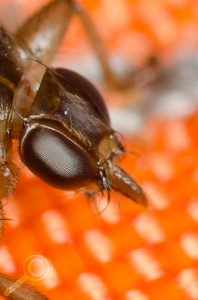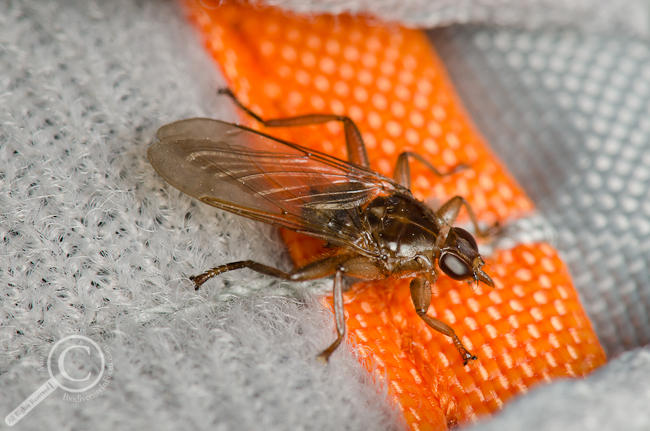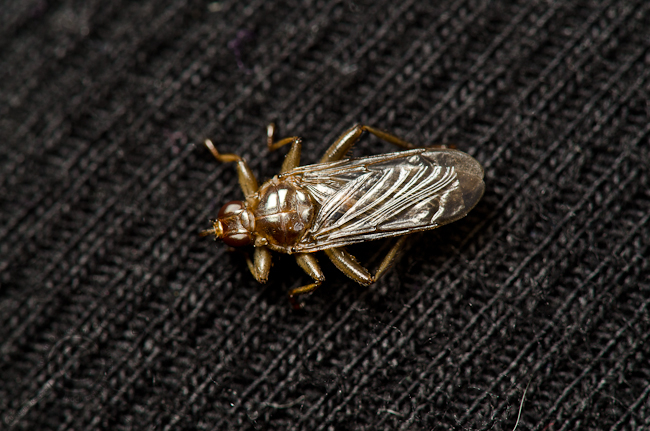Remember that last ID challenge I put to you? The one at the end of August which I’m only now getting around to answering? Ya, that one.
With the best turn out of commenters willing to wager on their IDs, I’m sorry it’s taken me so long to award those hard earned points. But no fear, that day is finally here!
It seems that Hippoboscidae have a face that more than it’s mother can love, as everyone correctly guessed the right family! I can’t say I blame the enthusiasm surrounding this fly, as their morphological adaptations for living on birds are pretty amazing!
Dorso-ventrally flattened to slide in amongst the feathers, plenty of thick setae on the thorax and abdomen which I assume are used for getting nestled in for the long haul, and trifurcated tarsal claws to hold onto their feathered hosts. Although I enjoy a morning bird watching from time to time, I’m not exactly a bird wrangler, so how did I come by this spectacular specimen? It seems my wife was putting out the bird vibes back in August while we were out hiking through Mono Cliffs Provincial Park (which is a fantastic hike by the way, definitely worth a visit if you’re in the area), and this fly latched on while we walked back to the parking lot.
Renee wasn’t all too impressed with her little hitchhiker, but I was ecstatic! I quickly scooped it off and put in my camera bag for a few snaps, all the while expecting it to get away. With these photos in hand, I threw it in my bag anticipating another opportunity to shoot it when I got home, but I guess all this excitement was too much, as it didn’t survive the car ride. Oh well, it found a good resting place in the Guelph Insect Collection, and also gave me a chance to identify it back in the lab.
Of course, that would prove more difficult than I had imagined, and I’m still not 100% confident in my final identification. The genus ID was relatively easy using the Manual of Nearctic Diptera, and I quickly had it keyed to the genus Icosta. That’s where the “fun” began however, as I tracked down the authoritative paper on Icosta taxonomy and biology published in 1969 by T.C. Maa of the Bishops Museum. Although the keys were well written and relatively well illustrated for a 1969 key, the characters needed for identification were anything but simple! I eventually ended up at Icosta ardeae (Macquart), although from what I could tell it was Icosta ardeae ardeae, a subspecies recorded from much of the Old World, ranging from the UK, down to South Africa and as far east as the Philippines and Australia! The other subspecies, Icosta ardeae botaurinorum, is listed as being known from North America, including Ontario, but the abdominal setae and wing shape illustrated just didn’t fit. Both species are known to choose herons as their preferred host, with I. a. botaurinorum breeding almost solely on American Bittern (Botaurus lentiginosus), which could very well have been lurking in the pond near the parking lot.
So what’s the deal; is it I. a. ardeae, or I. a. botaurinorum? I’m not a big believer in the idea of subspecies, so I’m happy simply calling it Icosta ardeae, but it speaks volumes about our understanding of the taxonomy of the family. Often found on birds (one of the best studied groups on earth), you would assume these flies would be as well studied and well collected as their avian counterparts, and yet I can’t get a definitive ID on one found 30 minutes from Toronto! Without any further taxonomic work since Maa’s 1969 revision, and with Maa leaving numerous species unnamed in his paper, simply calling them Icosta sp. “S” or sp. “N”, Icosta seems like a great project for someone interested in fly and bird taxonomy, and I could see a cool phylogenetic comparison between hippoboscid species and their avian hosts!
With that suggestion for the future, lets finish off the past and allocate some BioPoints! Chris scores a cool 15 points (3 for family, 4 for subfamily, 2 for being the first to answer and 6 for the review of hippoboscid larval biology), Laurie Knight picks up 8 (3 for family, 2 for picking a related species, and 3 for sharing her awesome photos of hippoboscid’s with mallophagan lice attached), Miles scores 3 points for his family ID, and Matt grabs 5 points (3 for family plus 2 for providing the morphological characters he used).
Thanks for playing once again everyone, and watch for more ID challenges in the near future (I mean it this time, I swear…)
All notes on taxonomy and biology of these flies was found in:
Maa, T.C. 1969. Revision of Icosta (=Lynchia Auctt.) with erection of a related genus Phthona. Pacific Insects Monograph 20: pg. 25-203.




[…] the exact species was easy because it turned out it was very common here in Italy. I read at Biodiversity in Focus that the reason they are flattened and have many setae on the thorax and the abdomen might be to […]